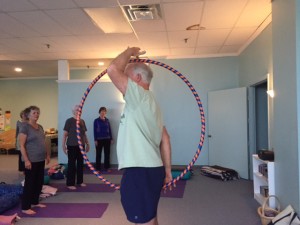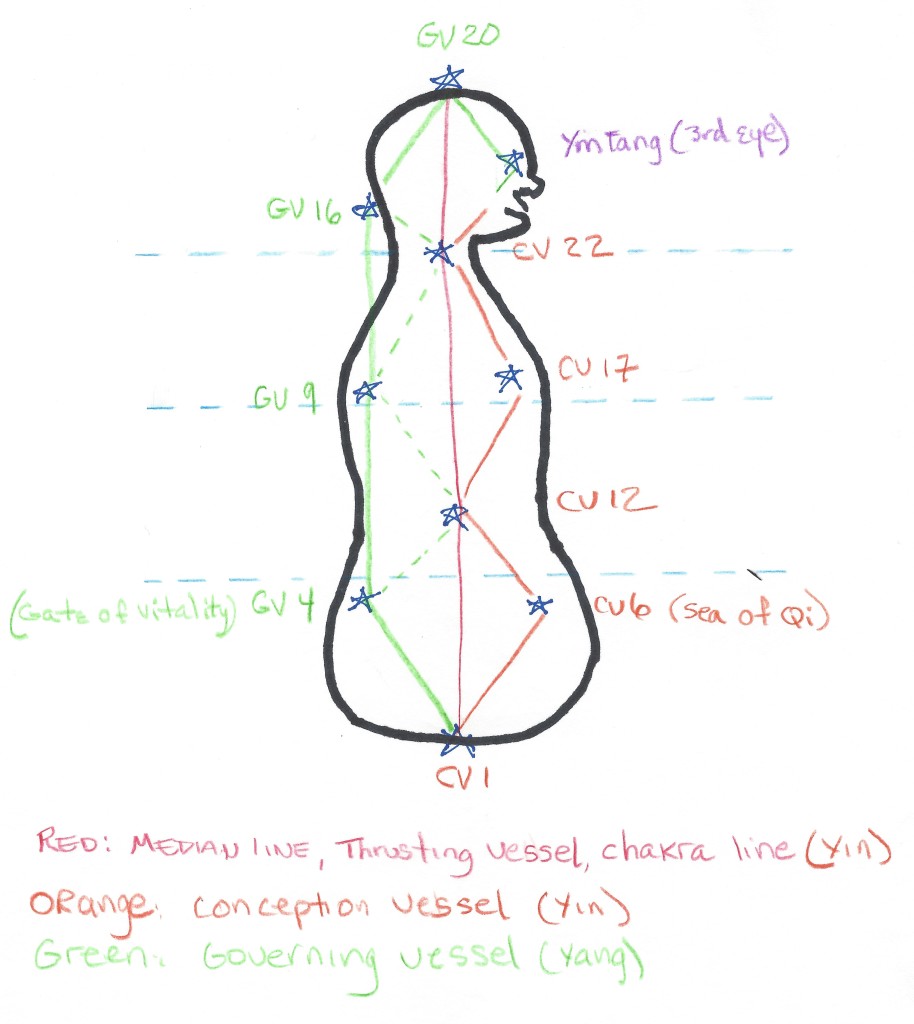Microscosmic Orbit, Abdominal Breathing and
Finding Support in the Asanas
(A little more detail than we covered in May, but consider it your homework for October.
Find your root chakra, aka CV-1 or the ‘seat of yin’.
Find your crown chakra, aka GV-20 , the ‘seat of yang’ or ‘hundred convergences’.

Visualize your ‘Conception Vessel’, Yin in nature, running along the front of the body, from the center of the perineum up to the bottom lip. As we are working with the energy fields, we can visualize this as most of the front circle as shown in the hula hoop below.
Visualize the Governing Vessel, Yang in nature, running from your perineum, up the back body, around the crown chakra and down to the upper lip.
Imagine them linked in a circle like the hoop below, outside the body, except for root and crown. Because we are working with the energy field as well as specific regions of the body, we can use the  circular image. Imagine a flow of energy following the circle, beginning at CV-1, moving up the front and down the back, linking root and crown. Then reverse, from CV-1 up the back and down the front.
circular image. Imagine a flow of energy following the circle, beginning at CV-1, moving up the front and down the back, linking root and crown. Then reverse, from CV-1 up the back and down the front.
For a greater challenge, try the double action of both at the same time to create the sense of a suspended field of energy. Relax as much as possible and then find the chakra line, aka the ‘Thrusting Vessel’, running as a diameter connecting root and crown from the inside.
Tucking and Untucking
If we take the double action just at the root chakra, or CV-1, we have the dynamic tuck/untuck action that activates and integrates the pelvic floor with legs and core. Try in simple sitting poses at first. Then tadasana. In uttanasana, try this: In going from tadasana into uttanasana, the primary action is untucking the sitting bones as the pelvis flexes/rotates around the femur heads. At the same time let the tucking action be taken at the coccyx to complete the double action. The reverse happens when going from uttanasana back to tadasana. Here the primary action is tucking the sitting bones down,  extending the pelvis around the femurs. Subtly let the tail bone untuck to complete the double action. Next feel the double action all the way through the crown as well.
extending the pelvis around the femurs. Subtly let the tail bone untuck to complete the double action. Next feel the double action all the way through the crown as well.
So, to reiterate, all backbends fundamentally require strong pelvic extension over the femurs, or strong tucking. Counterbalance by subtly untucking the coccyx. Now, as a beginner, your sitting bones and coccxy may be stuck together and the double action is difficult. Whatever action releases the spine for you in the moment is the correct one. Tucking the coccyx may feel opening. For beginners in forward bends, tight groins and hamstrings limit the ability to untuck the sitting bones. Be careful not to contract the spine trying to untuck. All forward bends require strong untucking of the sitting bones to deepen the flexion, but this has to come from a release of the front spine/psoas. Work with the image/energy of the circles to keep from collapsing or overworking.
For many beginning students, tadasana is a back bend because the groins are short and getting the pelvis parallel to the legs is a challenge. The double action can be learned in tadadana by squeezing a block with the thighs, internally rotating the femurs rolling the block backwards to untuck. Keep the action of the legs while you extend/tuck the pelvis. This action in double action of the pelvic region in tadasana is present in every asana, which is why tasdasana is said to be the root of all the asanas.
 In the asymetrica poses, where one hip joint flexes and one extends, the double action gets a bit tricky. In the pose to the left, the left hip is going into flexion requiring an ‘untucking of the sitting bones and a ‘tucking’ of the tail bone. The Right leg is tucking the sitting bones and untucking the tail. If you feel this deeply you ay notice that untucking opens the botton of the groin, below the pubis, and tucking opens the top of the groin, above the pubis. Ideally both top and bottom of the groins stay open to keep the energy freely flowing between torso and legs. Easier said than done!
In the asymetrica poses, where one hip joint flexes and one extends, the double action gets a bit tricky. In the pose to the left, the left hip is going into flexion requiring an ‘untucking of the sitting bones and a ‘tucking’ of the tail bone. The Right leg is tucking the sitting bones and untucking the tail. If you feel this deeply you ay notice that untucking opens the botton of the groin, below the pubis, and tucking opens the top of the groin, above the pubis. Ideally both top and bottom of the groins stay open to keep the energy freely flowing between torso and legs. Easier said than done!
Opening the Neck and Throat
To work with neck challenges, there is a double action between neck and skull that you can explore. In the diagram below, the base of the skull is near GV-16. When flexing the skull (bowing the head) GV-16 goes up. This will tend to push CV-22 just behind the sternal notch downward. The double action is to lift CV – 22 when flexing the neck. this keeps the throat soft and open. When looking upward and GV-16 is dropping, pull CV-22 downward as well. This keeps the back of the neck from collapsing into an isolated contraction. To help, us your fingers on the scalene muscles on the sides of the throat. Looking down, draw the scalenes up. Looking up, draw the scalenes down.
Abdominal Breathing:
In the chart above, notice the three diamonds. These correspond to the three bony cavities of the body; the skull, the rib cage, and the pelvis. Or in Tao’ist practice, three energy fields known as ‘dan tians’. In neuroscience, there are three different nervous systems corresponding to these spaces; the brain, the heart and the gut body, each with its own mode of ‘consciousness.
In general, when the breath flows freely through the lower dan tian or the region from the navel to the pelvic floor, the mind becomes quiet, the emotions settle, and the organism can store energy, like a battery being charged.
Sitting comfortably, imagining the three spaces and the energy field of the body, allow the inhalation to descend down to the pelvic floor. Feel CV-1, the seat of the yin pulling down like the subtle drawing of a bow. Feel the kidneys descending creating space for the lungs to expand. Keep the heart lifting gently, as if CV-12 is lifting as CV-1 drops. Feel the pelvis widening and deepening as well.
As you exhale, feel effortlessly CV-1 lifting and the abdominal wall slowly squeezing to release the breath. Keep your attention remaining down in the lower center during the exhalation so you strengthen your sense of ground and weight. Don’t force the breath, but invite it to expand and condense smoothly and evenly. You can practice smooth steady exhaling by adding an ‘O’ or ‘AH” sound, or blowing into a saxophone or other horn and sustaining an even tone.
The key is to keep you awareness down in to lower center and use the breath to soften and open the organs, tissues and cells. This ‘yin’ breathing is quieting and energizing.
Microcosmic Orbit Meditation.
When the abdominal breathing becomes stronger and easier, you can explore using some of the acupuncture cavities as reference points to focus your attention.
As you inhale and CV-1 descends, draw the energy up the front to CV-6. On the exhalation, let your attention flow back to CV-1. Repeat.
Or, inhale CV-1 to CV-6 to CV-12; exhale to GV-4 to CV-1, completing a small circuit. Repeat.
Or, inhale CV-1 to GV-4 to CV-12: exhale to CV-6 to CV-1. Repeat.
Use the chart to help you remember the cavities. Work your way up to CV 22 and then GV-20, up the front/down the back and then up the back and then down the front, always returning to CV-1.
Complete your practice by allowing the body to digest and integrate, either in simple sitting or savasana.


